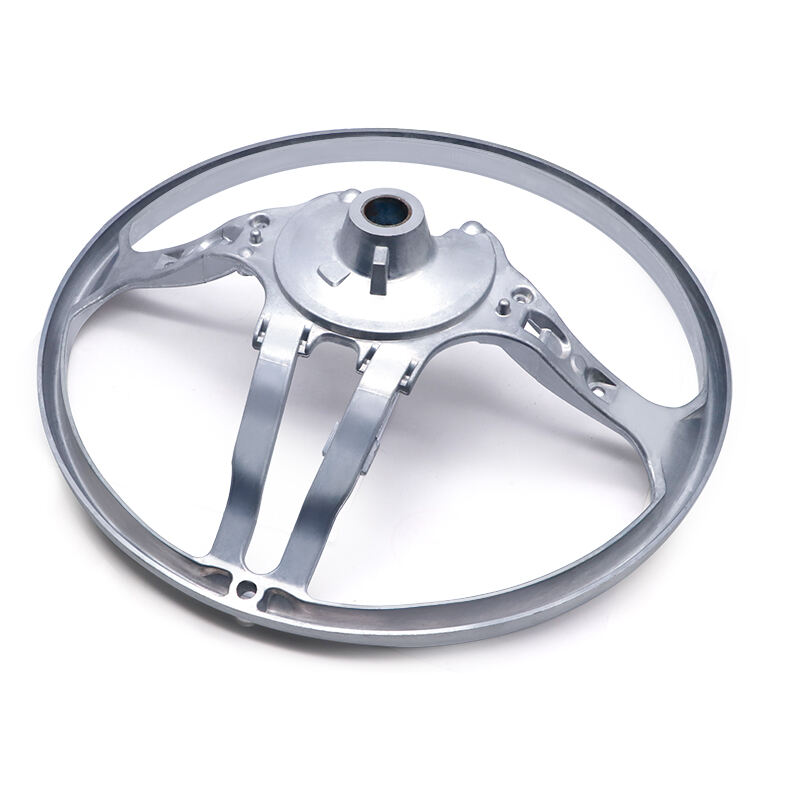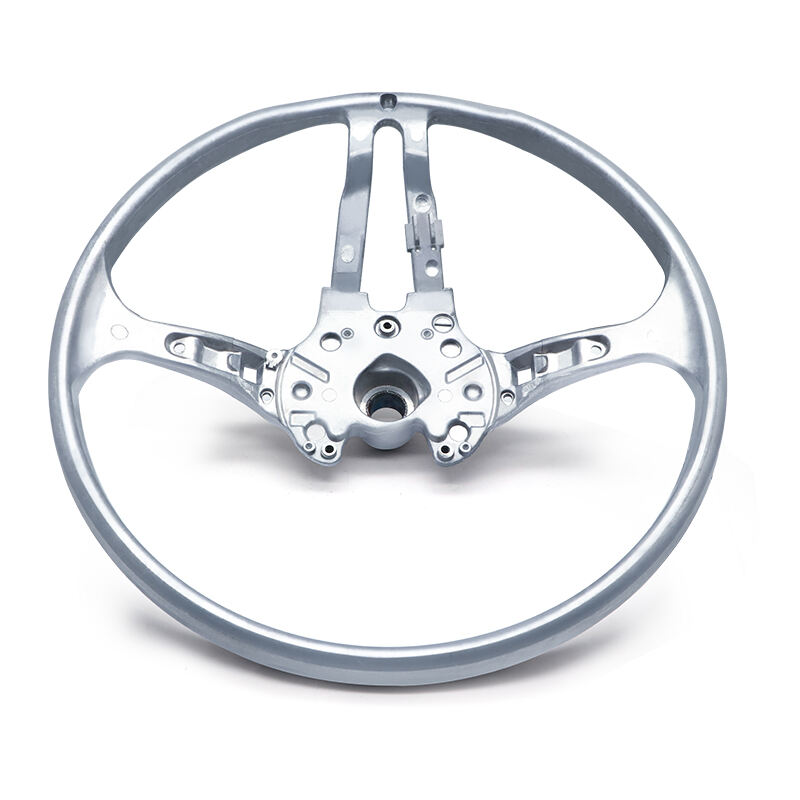Kaltlücken und Fehlläufe: Unvollständiges Füllen behandeln
Ursachen: Niedrige Metalltemperatur und turbulenter Fluss
Unvollständiges Füllen in druckguss führt oft zu Kaltlücken und Fehlläufen, hauptsächlich aufgrund einer niedrigen Metalltemperatur und eines turbulenten Flusses. Wenn das flüssige Metall nicht ausreichend Wärme beibehält, kann es die Form nicht richtig füllen, was zu Unstetigkeiten oder Nahtstellen führt, die als Kaltlücken bekannt sind. Zudem wird der turbulente Fluss durch eine schlechte Gusskanalgestaltung verschärft, was zu Inkonsistenzen während des Formfüllprozesses führt. Forschungen zeigen, dass die Gusstemperatur erheblich die Metallflüssigkeit beeinflusst und so das Gesamtfüllmuster beeinflusst. Durch empirische Studien dazu könnten wertvolle Erkenntnisse zur Optimierung des Diesgießprozesses und zur Minimierung von Fehlern wie Fehlläufen gewonnen werden.
Prävention: Temperaturregelung und verbesserte Gießanlagen-Design
Um Kaltlücken und unvollständige Gussvorgänge zu verhindern, ist die Implementierung präziser Temperaturregelmassnahmen essenziell. Dies stellt sicher, dass das geschmolzene Aluminium die notwendige Temperatur bis zur Injektion in die Form beibehält, wodurch ein vollständiges Füllen erreicht wird. Eine Überprüfung des Gießanlagen-Designs zur besseren Metallflussführung bekämpft direkt die Inkonsistenzen bei der Formfüllung. Techniken wie thermische Analyse können dabei helfen, optimale Temperaturbereiche zu identifizieren und notwendige Anpassungen an den Gießsystemen vorzuschlagen. Durch die Optimierung dieser beiden entscheidenden Faktoren – Temperaturregelung und Gießanlagen-Design – kann die Häufigkeit dieser üblichen Gussfehler erheblich reduziert und die Gesamtqualität verbessert werden.
Flachguss und Flachgusserzeugnisse: Management von Überschussmaterial
Ursachen: Formverschiebung und übermäßiger Druck
Blitzen beim Gießen wird oft auf eine Fehljustierung der Form und einen zu hohen Spritzdruck zurückgeführt. Eine Fehljustierung der Form kann auftreten, wenn die beiden Hälften der Form nicht perfekt ausgerichtet sind, was zu einer Ausfluss von flüssigem Metall durch die Lücken und zur Bildung von Blitzen führt. Ein Verständnis der Ursachen für Fehljustierungen, wie verschlissene Führungspins oder fehlerhafte Einrichtung, ist entscheidend, um diesen Fehler zu reduzieren. Darüber hinaus kann ein übermäßiger Spritzdruck flüssiges Material aus der Formkammer pressen und so die Bildung von Blitzen verschärfen. Laut Branchenberichten sind regelmäßige Justierungsprüfungen entscheidend, um Blitze zu verhindern und sicherzustellen, dass Produktionsläufe effizient und frei von Fehlern sind.
Minderung: Anpassung der Schließkraft und Formwartung
Um die Wahrscheinlichkeit von Flash zu minimieren, ist es entscheidend, die Schließkraft zu optimieren und regelmäßige Formwerkserhaltungsmaßnahmen durchzuführen. Die Schließkraft muss so eingestellt werden, dass eine vollständige Formschließung gewährleistet wird, ohne das Risiko der Bildung von Flash. Regelmäßige Wartung, die auch die Prüfung der Formintegrität und -ausrichtung umfasst, hilft dabei, vorzeitige Flashbildung zu verhindern und die Lebensdauer des Formwerks zu verlängern. Darüber hinaus können geplante Inspektionen auf Basis bewährter Verfahren die Häufigkeit von Flashsignifikant reduzieren. Durch kontinuierliche Wartung und Neukalibrierung bleibt das Formwerk in bestem Zustand, was die nachhaltige Qualität von Druckgusskomponenten sicherstellt.
Einschrumpfungsfehler beim Aluminiumdruckguss Besetzung
Einschrumpfung erkennen: Abkühlrate und Materialauswahl
Das Verständnis von Schrumpfungsfehlern beim Aluminium-Diesguß erfordert die Überwachung der Abkühlraten während der Verfestigung von flüssigem Aluminium. Diese Raten spielen eine Schlüsselrolle bei der Art und Weise, wie sich Schrumpfung äußert, da unausreichendes Abkühlen zu Fehlern führen kann, die die strukturelle Integrität beeinträchtigen. Darüber hinaus beeinflusst die Auswahl von Legierungen das Schrumpfungsverhalten erheblich; hochwertige Legierungen zeigen im Allgemeinen weniger Schrumpfung im Vergleich zu ihren minderwertigen Gegenstücken. Forschung, einschließlich Fallstudien und computergestützter Gußsimulationen, bestätigt die Korrelation zwischen Abkühlraten und den Schrumpfungsmerkmalen, die in Gußteilen beobachtet werden. Diese Studien ermöglichen präzise Anpassungen des Prozesses, um potenzielle Fehler zu minimieren.
Lösungen: Gleichmäßige Abkühlung und Legierungsoptimierung
Die Implementierung einheitlicher Kühlstrategien beim Schwerkraftguss ist entscheidend, um Schrumpfungsfehler effektiv zu vermeiden. Durch die sichere gleichmäßige Wärmeverteilung im Formen hilft einheitliches Kühlen, die strukturelle Integrität des Gusselements aufrechtzuerhalten. Darüber hinaus kann die Auswahl von Legierungen, die geringere Schrumpfraten aufweisen, positiv auf die Qualität des Endprodukts wirken. Andere praktische Lösungen umfassen den Einsatz von Kühlrippen und -kanälen, die in die Form integriert sind, um bei der gleichmäßigen Wärmeverteilung zu helfen. Diese Maßnahmen verbessern nicht nur die Produktqualität, sondern reduzieren auch die Auftreten von Fehlern, was zu zuverlässigeren Komponenten führt. In der Aluminium-Schwerkraftgießerei trägt das Berücksichtigen dieser Strategien zur dimensionsgenauen und strukturell soliden Herstellung von Teilen bei.
Risse und Heißbrüche: Strukturelle Schwächen
Thermischer Spannung und Formbeschrankungen als Hauptursachen
Thermischer Belastung ist ein kritischer Faktor bei der Entstehung von Rissen während des Druckgussprozesses. Schnelles Abkühlen kann diese Belastungen verstärken und zu strukturellen Schwächen in den Gussstücke führen. Ein Verständnis der thermischen Einschränkungen, denen Formen in jedem Gusszyklus ausgesetzt sind, ist essenziell, um diese potenziellen Schwachstellen zu bekämpfen. Die Quantifizierung thermischer Variationen ermöglicht es Herstellern, spannungsbedingte Probleme effektiv zu diagnostizieren und zu verhindern, unterstützt durch Studien, die zeigen, wie das Überwachen dieser Änderungen Defekte in Gussprodukten reduzieren kann.
Verhinderung von Rissen: Spannlösung und Anpassungen an der Formgestaltung
Verschiedene Techniken können nach dem Gießen angewendet werden, um das Risiko der Rissbildung zu verringern, wie z. B. Spannungsentlastung durch kontrolliertes Abkühlen. Darüber hinaus kann man proaktiv auf Spannungsaufbau reagieren, indem man Änderungen an den Formen vornimmt, um das thermische Ausdehnung zu berücksichtigen. Regelmäßige Überprüfungen der Formdesigns, geleitet durch Leistungsfeedback, können die Strategien zur Rissverhütung kontinuierlich verbessern und die Produktqualität erhöhen. Durch Verständnis und Umsetzung dieser Ansätze können Hersteller die Häufigkeit struktureller Schwächen in Schwerkunststoffprodukten erheblich reduzieren.

Präventive Strategien für Aluminium-Dies Besetzung Fehler
Optimierung des Formdesigns für einen reibungslosen Materialfluss
Die Optimierung der Formenentwurfs ist entscheidend für eine reibungslose Füllung beim Hochdruckguß aus Aluminium, was dazu beiträgt, Fehler zu vermeiden und die Produktivität zu steigern. Durch den Fokus auf Lauf- und Einspeisungssysteme können Formen modifiziert werden, um die Flusseigenschaften zu verbessern und sicherzustellen, dass flüssiges Metall die Hohlräume gleichmäßig füllt. Eine gut optimierte Form vereinfacht nicht nur den Gießprozess, sondern reduziert auch erheblich die Auftretensrate von Fehlern. Branchenstandards haben gezeigt, dass umgestaltete Formen für eine reibungslose Füllung oft zu weniger Fehlern und einer höheren Qualitätsausgabe führen, was zeigt, dass die Formenentwicklung eine wichtige präventive Strategie ist.
Prozesskontrolle: Überwachung von Geschwindigkeit, Druck und Temperatur
Strenge Prozesskontrolle über Spritzgeschwindigkeit, -druck und -temperatur ist entscheidend für die Gewährleistung der Qualität bei der Druckgussfertigung. Die Implementierung von Echtzeit-Überwachungstools ermöglicht unmittelbare Anpassungen und Verbesserungen während der Produktion, was eine Konsistenz über den gesamten Gießzyklus hinweg sichert. Zahlreiche Qualitätskontrollstudien betonen die Bedeutung dieser Parameter bei der Reduktion von Gießfehlern wie Porosität und Kaltschweiß. Durch präzise Prozesskontrolle können Hersteller die Häufigkeit von Fehlern reduzieren und die Gesamtreliabilität von Druckgussteilen verbessern.
Materialauswahl und Best Practices zur Legierungsreinheit
Die Auswahl der richtigen Materialien und die Sicherstellung der Legierungsreinheit sind grundlegend für die Verbesserung der Erträge beim Druckguss. Materialeigenschaften können die Gießergebnisse stark beeinflussen, und die Verwendung von hochreinen Legierungen kann Einschlüsse minimieren, was zu verbesserten mechanischen Eigenschaften und weniger Fehlern führt. Forschung bestätigt den Zusammenhang zwischen Materialreinheit und Gussintegrität und zeigt, dass geeignete Materialien und Legierungen zu überlegener Leistung und weniger Fehlern führen. Durch das Einhalten dieser Best Practices können Druckgießer die Qualität und Effektivität ihrer Produkte erheblich verbessern und so auf Dauer im Branchen Erfolg haben.
FAQ
Was sind kalte Verschlüsse und unvollständige Abläufe beim Druckguss?
Kalte Verschlüsse und unvollständige Abläufe beziehen sich auf Füllmängel beim Druckguss, die hauptsächlich durch niedrige Metalltemperaturen und turbulente Strömung verursacht werden.
Wie kann Temperaturregelung helfen, Gussmängel zu vermeiden?
Temperaturreglerung sorgt dafür, dass das flüssige Metall sich in der optimalen Temperatur für eine vollständige Formfüllung befindet und reduziert so Fehler wie kalte Verschlüsse und Fehlläufe.
Warum ist die Formgestaltung im Druckguss entscheidend?
Die Formgestaltung beeinflusst den Materialfluss, die Abkühlrate und die Bildung von Fehlern beim Druckguss. Optimale Designs verbessern den Fluss und reduzieren Fehler wie Verklebung und Schrumpfung.
Wie beeinflussen Abkühlraten die Schrumpfung beim Aluminiumdruckguss?
Unangemessene Abkühlraten können zu Schrumpfungsfehlern führen, die die Strukturintegrität der gegossenen Produkte gefährden. Eine gleichmäßige Abkühlung hilft dabei, diese Fehler zu verwaltern.
Welche Rolle spielt die Werkstoffauswahl beim Aluminiumdruckguss?
Die Werkstoffauswahl, einschließlich Legierungsqualität und -reinheit, beeinflusst erheblich die Gießergebnisse. Hochreine Legierungen verbessern die mechanischen Eigenschaften und reduzieren Fehler.
Table of Contents
- Kaltlücken und Fehlläufe: Unvollständiges Füllen behandeln
- Flachguss und Flachgusserzeugnisse: Management von Überschussmaterial
- Einschrumpfungsfehler beim Aluminiumdruckguss Besetzung
- Risse und Heißbrüche: Strukturelle Schwächen
- Präventive Strategien für Aluminium-Dies Besetzung Fehler
-
FAQ
- Was sind kalte Verschlüsse und unvollständige Abläufe beim Druckguss?
- Wie kann Temperaturregelung helfen, Gussmängel zu vermeiden?
- Warum ist die Formgestaltung im Druckguss entscheidend?
- Wie beeinflussen Abkühlraten die Schrumpfung beim Aluminiumdruckguss?
- Welche Rolle spielt die Werkstoffauswahl beim Aluminiumdruckguss?

